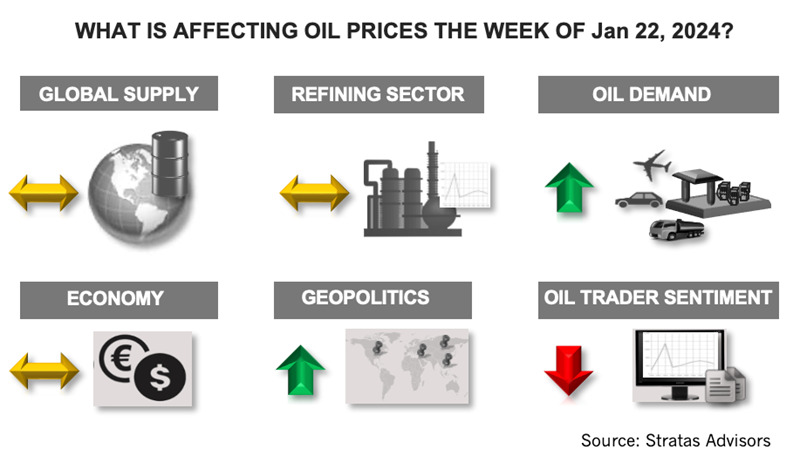
International geopolitical risks continue to increase, but Paisie expects the oil market will stay steady unless conflicts create a material impact on oil flows. (Source: Shutterstock)
The price of Brent crude ended the week at $78.56 after closing the previous week at $78.29. The price of WTI ended the week at $73.71 after closing the previous week at $72.68. The price of DME Oman crude ended the week at $78.11.

The price of Brent crude remains below its 200-day moving average, although the price has drifted upward since falling to $73.24 on Dec. 12, 2023. The sentiment of oil traders continues to be negative. The net long positions of Brent traders remain at a low level, as do the net long positions of WTI traders. The net long positions remain at depressed level and near the level seen in July 2023 before the announcement of the voluntary cut of 1 MMbbl/d by Saudi Arabia. Since late September, traders of WTI have reduced their net long positions by more than 70%.
Meanwhile, the scope of geopolitical risks continues to expand with the following recent developments:
An apparent airstrike by Israel killed five Iranian officers in Damascus, Syria. Iran has vowed to respond. Additionally, Russia military aircraft has started to patrol the border between Israel and Syria.
There are also reports that Israel employed a missile strike in Lebanon, which resulted in a member of Hezbollah being killed.
Militants in Iraq, supported by Iran, launched missiles at the U.S. forces at al-Asad air base on Jan. 20. Since mid-October there has been 140 attacks on U.S. forces in Iraq and Syria. The recent, however, is being considered an escalation since the attack included the use of ballistic missiles.
The Houthis have continued with drone and missile attacks on shipping through the Red Sea. In response, the U.S. has been patrolling the Red Sea with warships and employing missile strikes in Yemen against the Houthis.
Iran and Pakistan exchanged airstrikes last week with Iran attacking bases for the Sunni separatist group Jaish al-Adl in southwestern Pakistan on Jan. 16. Pakistan responded by attacking training camps of Baluch insurgents on southeaster Iran. On Jan. 19, Iran And Pakistan promised to deescalate.
Besides the above developments, the Russia-Ukraine conflict continues and concerns about China and Taiwan remain. There are also the tensions between Venezuela and Guyana over control over the Essequibo region.
While the geopolitical risks are increasing, we are expecting the oil market will continue discounting the geopolitical risks unless there is a material impact on oil flows. Without such an impact on oil flows, we are expecting that during the first quarter of 2024, oil prices will bounce upwards with negative geopolitical news, but the price increase will quickly fade once the market sees that oil is still flowing.
For a complete forecast of refined products and prices, please refer to our Short-term Outlook.
About the Author: John E. Paise, president of Stratas Advisors, is responsible for managing the research and consulting business worldwide. Prior to joining Stratas Advisors, Paisie was a partner with PFC Energy, a strategic consultancy based in Washington, D.C., where he led a global practice focused on helping clients (including IOCs, NOC, independent oil companies and governments) to understand the future market environment and competitive landscape, set an appropriate strategic direction and implement strategic initiatives. He worked more than eight years with IBM Consulting (formerly PriceWaterhouseCoopers, PwC Consulting) as an associate partner in the strategic change practice focused on the energy sector while residing in Houston, Singapore, Beijing and London.
Recommended Reading
TotalEnergies Acquires Eagle Ford Interest, Ups Texas NatGas Production
2024-04-08 - TotalEnergies’ 20% interest in the Eagle Ford’s Dorado Field will increase its natural gas production in Texas by 50 MMcf/d in 2024.
Santos’ Pikka Phase 1 in Alaska to Deliver First Oil by 2026
2024-04-18 - Australia's Santos expects first oil to flow from the 80,000 bbl/d Pikka Phase 1 project in Alaska by 2026, diversifying Santos' portfolio and reducing geographic concentration risk.
Tech Trends: Halliburton’s Carbon Capturing Cement Solution
2024-02-20 - Halliburton’s new CorrosaLock cement solution provides chemical resistance to CO2 and minimizes the impact of cyclic loading on the cement barrier.
E&P Highlights: Feb. 26, 2024
2024-02-26 - Here’s a roundup of the latest E&P headlines, including interest in some projects changing hands and new contract awards.
BP: Gimi FLNG Vessel Arrival Marks GTA Project Milestone
2024-02-15 - The BP-operated Greater Tortue Ahmeyim project on the Mauritania and Senegal maritime border is expected to produce 2.3 million tonnes per annum during it’s initial phase.





